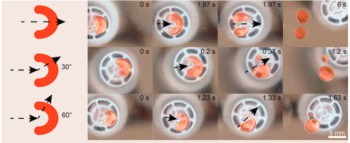Flash Physics is our daily pick of the latest need-to-know developments from the global physics community selected by Physics World‘s team of editors and reporters
Frozen droplets explode on camera
Exploding frozen water droplets have been filmed at high speed. As a droplet of water freezes from the outside in, it can explode in a shower of ice shards. Although the phenomenon is known to be caused by the self-confinement of the initial ice shell and expansion of the water inside as it solidifies, the mechanisms leading to the explosion are mostly unknown. A team from the University of Twente in the Netherlands has used high-speed cameras and computer modelling to study the event from the formation of the first ice crystals to the moment the droplet bursts. To do so, they supercooled millimetre-size droplets in a specially designed chamber. This meant that the water was below freezing point but free from ice crystals – which ensured a reproducible starting point for the experiments. Sander Wildeman and colleagues then triggered the freezing process by touching the droplet with a small tip. This caused a shell of ice to encapsulate the drop within microseconds. As the liquid water within the centre becomes compressed by the shell expanding inwards, the shell itself undergoes intermediate fracturing and healing. Furthermore, the scientists observed that some of the pressure is released as an “arm” of ice that extends from the droplet. Within about 2 s, the droplet shatters and sprays ice shards at a velocity in the order of 1 m/s. Using computer modelling, the team concluded that the droplets only explode if their diameter is larger than 50 μm. Below this, the surface tension of the ice shell is strong enough to balance the internal pressure and keep the droplet intact. The study, described in Physical Review Letters, could help in understanding how hail and other precipitation form.
Patricia Bassereau wins Emmy Noether physics prize

The Autumn-Winter 2016 Emmy Noether Distinction for Women in Physics prize has been given to Patricia Bassereau of the Institute Curie Research Centre in Paris, France. Awarded by the European Physical Society, the prize was given to Bassereau for “her important and innovative work on the studies of soft matter and in vitro biological systems at the forefront of biophysics. Her rich and fruitful career is an inspiration for young women researchers.” Bassereau leads the Membrane and Cell Functions research group at the Institute Curie, where she is currently working on the physics of biological membranes including non-equilibrium systems, molecular motors and biomimetic systems. Describing the importance of mentorship for women embarking on careers in science she says: “I have been lucky to meet great scientists who gave me advice, helped me gain self-confidence and also believed I could perform interesting science.”
Bright gamma-ray sources spotted at centre of Andromeda

Most gamma rays emanating from the Andromeda galaxy come from its centre, rather than throughout the galaxy, as previously expected. That is the conclusion of astronomers who have used NASA’s Fermi Gamma-ray Space Telescope to study Andromeda, which at 2.5 million light-years distance is the nearest major galaxy to Earth. The result is reminiscent of the previous – and unexpected – observation by Fermi that there is an excess of gamma rays coming from the centre of the Milky Way. The astronomers have proposed several explanations for the Andromeda observation. One is that the gamma rays are produced by the decay of hypothetical dark-matter particles, which are expected to concentrate at galactic centres. Another is that there may be an unexpectedly high concentration of pulsars at the centre. These are spinning neutron stars that emit copious gamma rays. The next step for the team is to look at X-ray and radio emissions, which could help scientists work out if the gamma rays are indeed produced by pulsars. The observations are described in The Astrophysical Journal.
- You can find all our daily Flash Physics posts in the website’s news section, as well as on Twitter and Facebook using #FlashPhysics. Tune in to physicsworld.com later today to read today’s extensive news story on a new fluorescence microscopy technique.



